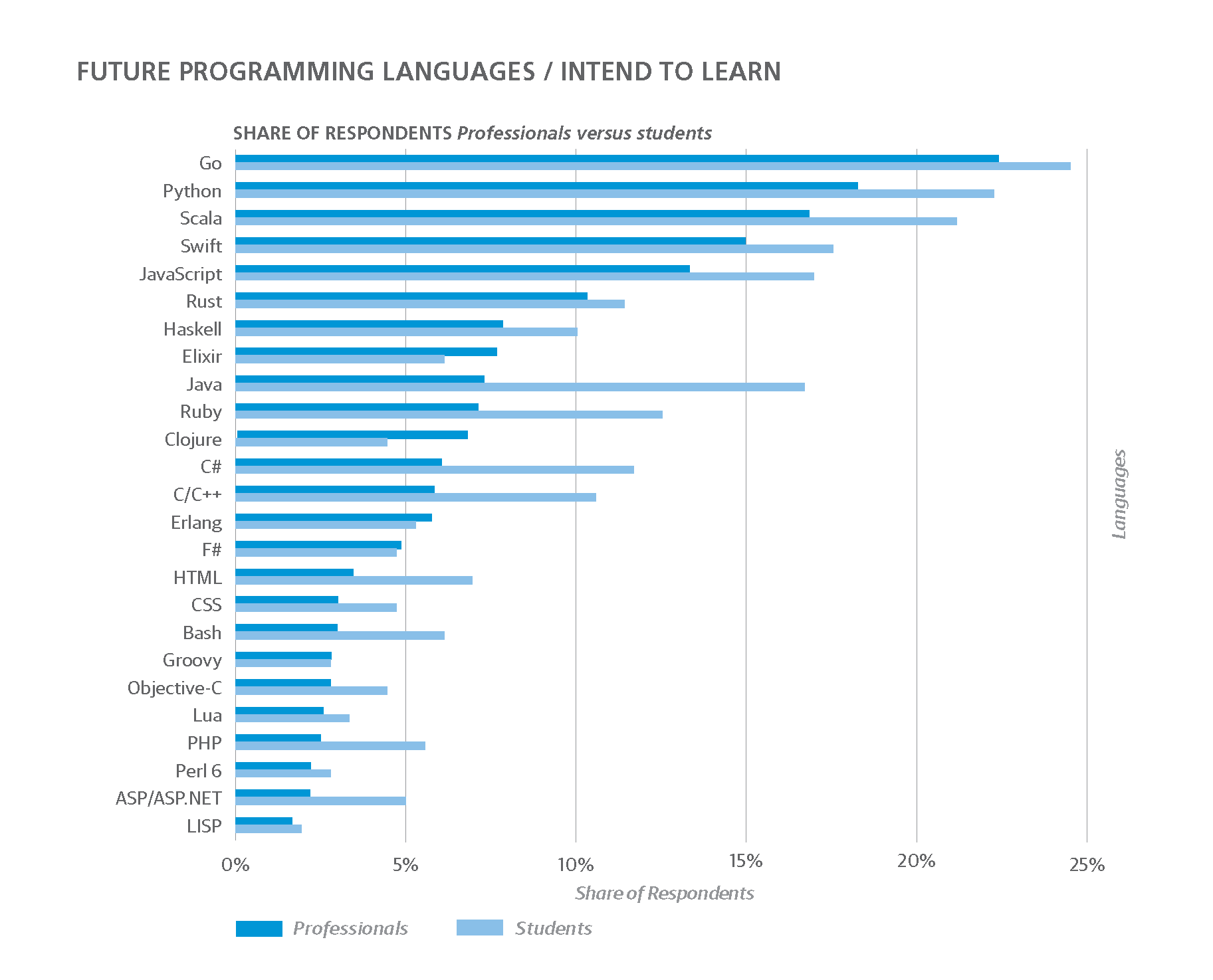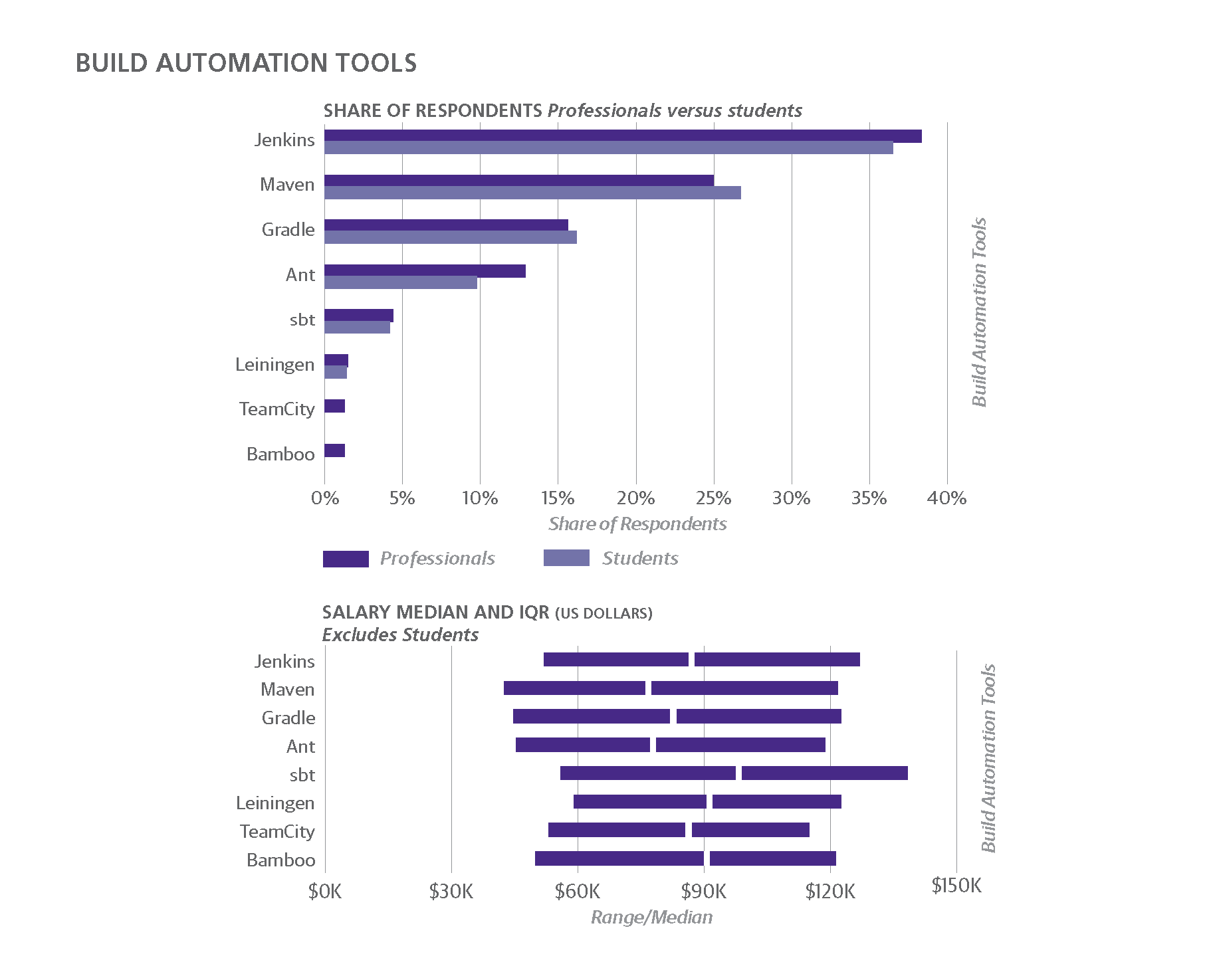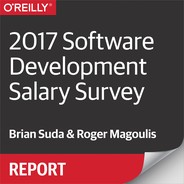Tools and Programming Languages
NEW TOOLS ARE ALWAYS APPEARING and others maturing and disappearing. Knowing what operating systems, programming languages, text editors, IDEs, data tools, build tools, cloud containers, and frameworks that people are using allows us to see trends in the industry.
These charts include both student and non-student responses. It is interesting to see which tools the next generation of programmers are familiar with and which will potentially need to be learned on the job.
Our results show that programming languages, operating systems, and platforms sometimes trend together. For instance, Objective-C is being replaced by Swift in the future programming languages category. We saw Objective-C drop 2% in popularity compared to last year’s survey and Swift make its first appearance on the list, coming in fourth at 15%. In the OS category, macOS usage dropped almost 8% compared to last year’s survey. Similarly, iOS development dropped a percentage point (from 11% to 10%), but Xcode use increased 6%.
There are now more Android developers than last year (12% versus 11%). Android Studio made its first appearance as an IDE this year, with 7% of our respondents using it. Java holds strong as a popular programming language (36%) and as a past and future programming language (24% and 7%, respectively).
While Android is written mainly in Java, Google’s other programming language, Go, is also a hot topic. Only about 4.5% of the respondents say they use Go, while less than 2% say they’ve used it in the past, but it’s a new language, so this is understandable. Go ranks first among future programming languages, with 23% of the respondents wanting to learn it. When we look at the 2016 survey results, we see a similar number: Go was also the highest ranked programming language to learn (23%). Many want to learn Go, but people either don’t seem to have the time or Go isn’t being adopted enough within companies for folks to learn it on the job or for everyday tasks.
Microsoft has made some big announcements in the last 12 months. From new hardware, to more open source offerings, to software updates, they are definitely a company to watch. So how has that affected usage? The percentage of people using Windows has held steady at 62% over the last two years. However, Microsoft’s main programming languages— C#, ASP.net, and VB.net—have seen a decline in their everyday usage (2%, 3%, and 2%, respectively). In terms of languages that people want to learn, C# has seen a slight 1% increase, Visual Studio IDE is down slightly (2%), and their cloud platform Azure is up 1%.
Past Languages
The top three programming languages our respondents have used professionally in the past haven’t changed much over the last year. C/C++ (35%), Java (24%), and PHP (21%) dominate the top of the list, just like last year.
There are small changes with less popular languages. VB.NET (16% of respondents) and ASP.NET (12%) have dropped 1%–2% compared to last year, most likely being replaced with C#. HTML increased from 13% to 16%, and JavaScript went from 12% to 14%.
The popularity of a programming language is not a good predictor of salary, which makes sense: sometimes obscure languages are in demand for specific applications and the few people who know those languages can make a lot of money. Other languages are widely known, but since they are also widely used in many different applications, they pay well. C/ C++, for example, garners a median salary of $85K—higher than our average.
Perl 5, Perl 6, and Groovy all have well-paid median salaries ($110K), with the top 25% of respondents who used these languages making more than $130K.
Student responses about past programming languages are interesting because these are folks who will be entering the workforce. What they are taught at school and what they are learning on their own can be an indicator of what’s to come. C/C++ dominates the top spot, just as with non-students, with C# coming in second at 22%. This is important because, for non-students, C# is fourth at 17%. Only 20% of students have used Java, compared to 24% of non-students. These are interesting indicators that students are being taught more C# and less Java. In the near future, we might see a need for more Java training and/or a rise in C# programming.
2.5% of students are familiar with Swift, Apple’s new programming language, but Swift is not on the list for non-students. Go is also interesting in that 3% of the students have some experience with it, whereas only 1.6% of the non-students do. Since both of these languages are fairly new, it’s understandable that students have more exposure to them, and more time to experiment with and learn them. Non-students might have less free time and be required to use languages their employers have chosen.
Future Languages
Everyone wants to learn more Go, Python, Scala, Swift, and JavaScript (in that order). These are the top five languages that both students and non-students hope or intend to learn.
For students, Java, PHP, and C/C++ are highly desirable, too, which makes sense because those are the languages being used in companies, so knowing them can help students enter the workforce. For non-students, Rust, Haskell, and Elixir are also high on the list of languages they want to learn.













